-
 Bitcoin
Bitcoin $117900
0.31% -
 Ethereum
Ethereum $3766
0.28% -
 XRP
XRP $3.176
-0.31% -
 Tether USDt
Tether USDt $1.000
0.00% -
 BNB
BNB $795.6
1.51% -
 Solana
Solana $186.8
-1.09% -
 USDC
USDC $0.9999
-0.01% -
 Dogecoin
Dogecoin $0.2353
-1.33% -
 TRON
TRON $0.3226
1.49% -
 Cardano
Cardano $0.8172
-1.08% -
 Sui
Sui $4.178
3.06% -
 Hyperliquid
Hyperliquid $43.05
-3.39% -
 Stellar
Stellar $0.4367
-0.57% -
 Chainlink
Chainlink $18.62
1.47% -
 Hedera
Hedera $0.2828
6.63% -
 Bitcoin Cash
Bitcoin Cash $584.7
5.65% -
 Avalanche
Avalanche $24.81
2.53% -
 Litecoin
Litecoin $112.8
-0.88% -
 UNUS SED LEO
UNUS SED LEO $8.975
-0.08% -
 Shiba Inu
Shiba Inu $0.00001395
-1.07% -
 Toncoin
Toncoin $3.285
-1.05% -
 Ethena USDe
Ethena USDe $1.001
0.01% -
 Polkadot
Polkadot $4.123
0.76% -
 Uniswap
Uniswap $10.49
-0.18% -
 Monero
Monero $326.5
0.14% -
 Dai
Dai $0.9999
-0.02% -
 Bitget Token
Bitget Token $4.576
0.34% -
 Pepe
Pepe $0.00001247
-1.55% -
 Cronos
Cronos $0.1400
3.77% -
 Aave
Aave $295.1
-0.73%
ROC indicator peaks and falls back? Practical application of momentum indicator
The ROC indicator helps traders gauge momentum in crypto markets; peaks and falls can signal potential price reversals for informed trading decisions.
Jun 10, 2025 at 06:57 pm
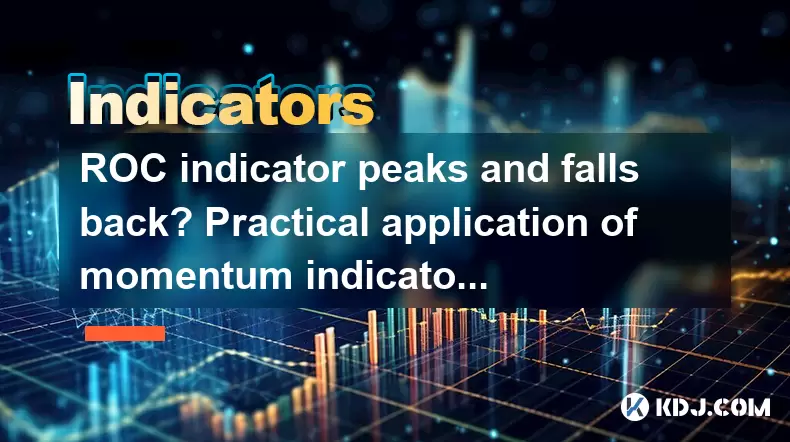
The Rate of Change (ROC) indicator is a popular momentum oscillator used by traders in the cryptocurrency market to gauge the speed and change of price movements. When the ROC indicator peaks and subsequently falls back, it can provide valuable insights into market momentum and potential price reversals. This article delves into the practical application of the ROC indicator, focusing on how traders can interpret peaks and subsequent declines to make informed trading decisions.
Understanding the ROC Indicator
The ROC indicator measures the percentage change in price over a specified period. It is calculated by taking the current price and subtracting the price from a certain number of periods ago, then dividing that difference by the price from the earlier period and multiplying by 100. The formula is as follows:
[ \text{ROC} = \left( \frac{\text{Current Price} - \text{Price n periods ago}}{\text{Price n periods ago}} \right) \times 100 ]
The resulting value oscillates around a zero line, where positive values indicate upward momentum and negative values indicate downward momentum. Peaks in the ROC indicate strong momentum, while troughs suggest weakening momentum.
Identifying Peaks and Falls in the ROC Indicator
When the ROC indicator reaches a peak, it signifies that the momentum of the price movement has reached its maximum point. This peak can be a signal of potential overbought conditions, especially if the ROC value is significantly high. Conversely, when the ROC falls back after a peak, it suggests that the momentum is waning, which could indicate an upcoming price correction or reversal.
To identify these peaks and falls, traders should:
- Monitor the ROC line for significant highs that deviate from the average range.
- Observe the subsequent movement of the ROC line after the peak to confirm a fall.
- Compare the current peak and fall with historical data to gauge the strength of the momentum shift.
Practical Application of ROC Peaks and Falls
The practical application of ROC peaks and falls involves using these signals to make trading decisions. Here are some strategies traders can employ:
Entering a Position
When the ROC indicator reaches a peak and then falls back, it can be an opportune time to enter a short position. The falling ROC suggests that the upward momentum is fading, and a price correction may follow. Traders should:
- Wait for the ROC to peak and then start to decline.
- Confirm the fall with additional indicators, such as the Relative Strength Index (RSI) or Moving Average Convergence Divergence (MACD).
- Enter a short position once the decline is confirmed, setting appropriate stop-loss and take-profit levels.
Exiting a Position
For those already in a long position, a peak followed by a fall in the ROC can signal a good time to exit the trade. The declining momentum indicates that the price may soon reverse. Traders should:
- Monitor the ROC for a peak and subsequent fall.
- Use additional technical analysis tools to confirm the momentum shift.
- Exit the long position once the fall is confirmed, securing profits before a potential price drop.
Identifying Reversals
A significant peak followed by a sharp fall in the ROC can also indicate a potential price reversal. This is particularly useful for swing traders looking to capitalize on market turns. To identify reversals, traders should:
- Look for an extreme peak in the ROC that is well above the average range.
- Watch for a rapid decline in the ROC after the peak, ideally crossing below the zero line.
- Confirm the reversal with other indicators, such as price action or volume analysis.
- Enter a position in the direction of the anticipated reversal, setting appropriate risk management parameters.
Combining ROC with Other Indicators
While the ROC indicator is powerful on its own, combining it with other technical indicators can enhance its effectiveness. Here are some common combinations:
ROC and RSI
The Relative Strength Index (RSI) is another momentum oscillator that measures the speed and change of price movements. When used in conjunction with the ROC, traders can get a more comprehensive view of market momentum. For instance:
- If the ROC peaks and falls while the RSI is above 70, it may indicate an overbought condition and a potential price drop.
- Conversely, if the ROC peaks and falls while the RSI is below 30, it may suggest an oversold condition and a potential price rise.
ROC and MACD
The Moving Average Convergence Divergence (MACD) is a trend-following momentum indicator that shows the relationship between two moving averages of a security's price. Combining the ROC with the MACD can provide additional confirmation of momentum shifts. For example:
- If the ROC peaks and falls while the MACD line crosses below the signal line, it can confirm a bearish momentum shift.
- If the ROC peaks and falls while the MACD line crosses above the signal line, it can confirm a bullish momentum shift.
Setting Up the ROC Indicator on Trading Platforms
To effectively use the ROC indicator, traders need to set it up correctly on their trading platforms. Here is a step-by-step guide for setting up the ROC on popular trading platforms:
Setting Up ROC on MetaTrader 4 (MT4)
- Open the MT4 platform and select the chart where you want to apply the ROC.
- Click on "Insert" in the top menu, then navigate to "Indicators" and select "Custom."
- Choose "ROC" from the list of available indicators.
- In the ROC settings window, set the period to your preferred number of periods (commonly 12 or 14).
- Adjust the style and color of the ROC line to your liking.
- Click "OK" to apply the indicator to the chart.
Setting Up ROC on TradingView
- Open the TradingView platform and select the chart where you want to apply the ROC.
- Click on the "Indicators" button at the top of the chart.
- In the search bar, type "ROC" and select the "Rate of Change" indicator from the list.
- In the settings window, adjust the length to your preferred number of periods.
- Customize the appearance of the ROC line as desired.
- Click "Save and Apply" to add the indicator to the chart.
Using ROC in Different Timeframes
The ROC indicator can be used across various timeframes, from short-term intraday charts to long-term weekly or monthly charts. The choice of timeframe depends on the trader's strategy and goals. Here are some considerations for different timeframes:
Short-Term Trading
For intraday trading, a shorter period for the ROC (such as 9 or 12 periods) can be used to capture quick momentum shifts. Traders should:
- Monitor the ROC closely for rapid peaks and falls.
- Use shorter timeframes (like 15-minute or 1-hour charts) to identify intraday trading opportunities.
- Combine the ROC with other short-term indicators for confirmation.
Medium-Term Trading
For swing trading, a medium period for the ROC (such as 14 or 21 periods) can provide insights into medium-term momentum shifts. Traders should:
- Use daily charts to track the ROC over several days or weeks.
- Look for sustained peaks and falls to identify potential swing points.
- Combine the ROC with other medium-term indicators for better accuracy.
Long-Term Trading
For position trading, a longer period for the ROC (such as 28 or 50 periods) can be used to understand long-term trends. Traders should:
- Use weekly or monthly charts to analyze the ROC over extended periods.
- Identify significant peaks and falls that may indicate major trend reversals.
- Combine the ROC with other long-term indicators for comprehensive analysis.
Frequently Asked Questions
Q: Can the ROC indicator be used as a standalone tool for trading decisions?
A: While the ROC indicator is a powerful tool for gauging momentum, it is generally recommended to use it in conjunction with other technical indicators and price action analysis to increase the accuracy of trading signals. Relying solely on the ROC may lead to false signals and potential losses.
Q: How does the choice of period affect the ROC indicator's signals?
A: The choice of period for the ROC indicator significantly impacts its sensitivity and the type of signals it generates. A shorter period (e.g., 9 periods) will make the ROC more responsive to price changes, suitable for short-term trading. A longer period (e.g., 28 periods) will smooth out the ROC line, making it more appropriate for identifying longer-term trends.
Q: Is the ROC indicator more effective in trending or ranging markets?
A: The ROC indicator tends to be more effective in trending markets, where it can clearly indicate the strength and direction of the trend. In ranging markets, the ROC may produce more false signals as it oscillates around the zero line, making it challenging to distinguish between meaningful momentum shifts and noise.
Q: How can traders avoid false signals when using the ROC indicator?
A: To avoid false signals, traders should use the ROC indicator in combination with other technical analysis tools, such as trend lines, support and resistance levels, and additional momentum indicators. Additionally, waiting for confirmation from other indicators before acting on ROC signals can help filter out false positives and enhance trading decisions.
Disclaimer:info@kdj.com
The information provided is not trading advice. kdj.com does not assume any responsibility for any investments made based on the information provided in this article. Cryptocurrencies are highly volatile and it is highly recommended that you invest with caution after thorough research!
If you believe that the content used on this website infringes your copyright, please contact us immediately (info@kdj.com) and we will delete it promptly.
- Cryptos to Watch in 2025: Punisher Coin, Chainlink, and the Altcoin Arena
- 2025-07-27 18:30:13
- Bitcoin, Altcoins, Rebound: Navigating the Crypto Comeback Trail
- 2025-07-27 18:30:13
- Ethereum, Bitcoin, and Altcoins: A Shift in Crypto Tides?
- 2025-07-27 19:10:13
- Windtree Therapeutics' Bold BNB Strategy: A $520 Million Crypto Play
- 2025-07-27 19:10:13
- Solana, Staking, and Unilabs: What's the Buzz in the Crypto Space?
- 2025-07-27 16:50:13
- VeChain, HBAR, Remittix: Navigating the Crypto Landscape in 2025
- 2025-07-27 17:10:12
Related knowledge
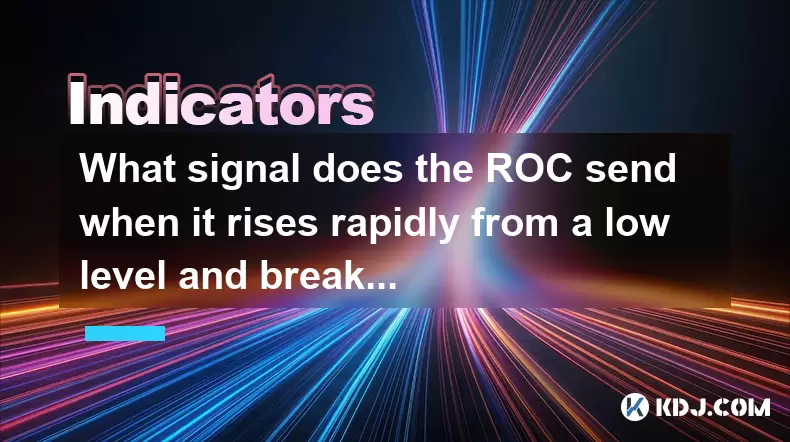
What signal does the ROC send when it rises rapidly from a low level and breaks through the zero axis?
Jul 27,2025 at 10:15am
Understanding the Rate of Change (ROC) IndicatorThe Rate of Change (ROC) is a momentum-based oscillator used in technical analysis to measure the perc...
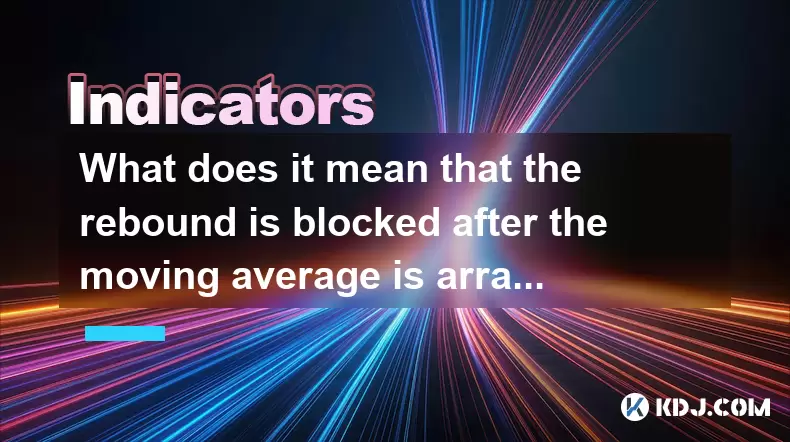
What does it mean that the rebound is blocked after the moving average is arranged in a short position for the first time?
Jul 26,2025 at 10:51am
Understanding the Short-Term Moving Average ConfigurationWhen traders refer to a 'short position arrangement' in moving averages, they are describing ...
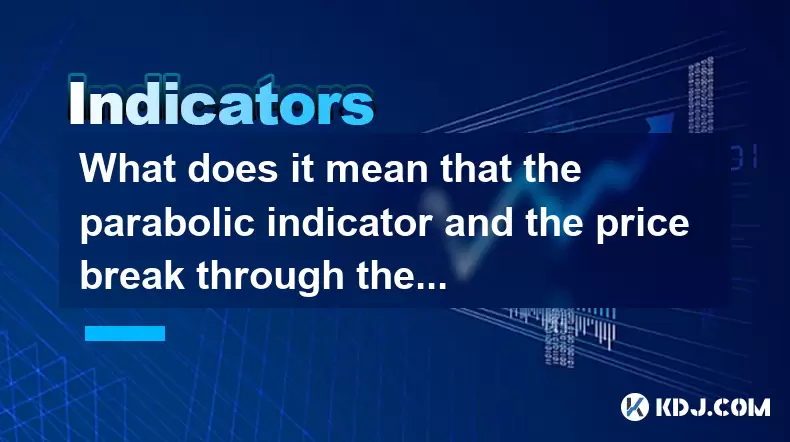
What does it mean that the parabolic indicator and the price break through the previous high at the same time?
Jul 26,2025 at 07:22pm
Understanding the Parabolic Indicator (SAR)The Parabolic SAR (Stop and Reverse) is a technical analysis tool developed by J. Welles Wilder to identify...
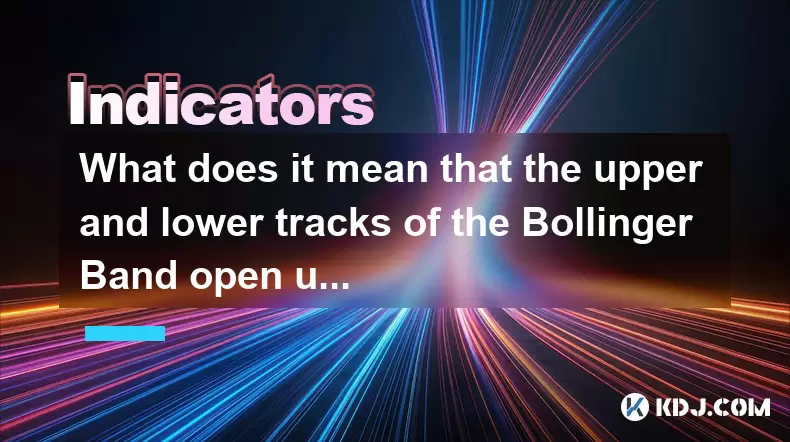
What does it mean that the upper and lower tracks of the Bollinger Band open upward at the same time?
Jul 27,2025 at 02:49pm
Understanding the Bollinger Band StructureThe Bollinger Band is a widely used technical analysis tool developed by John Bollinger. It consists of thre...
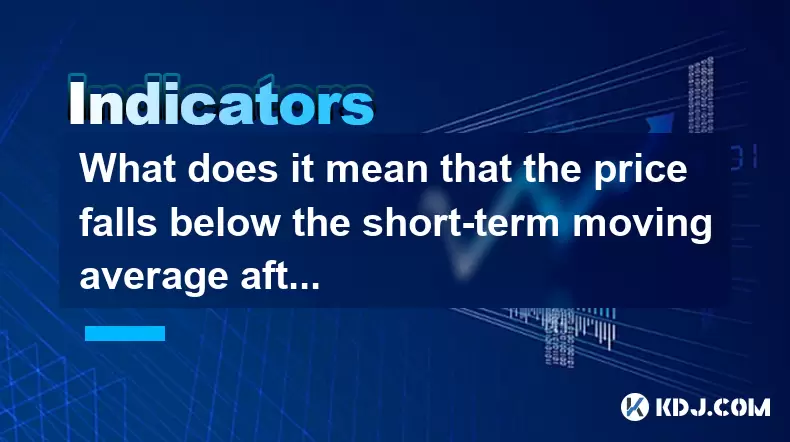
What does it mean that the price falls below the short-term moving average after the RSI top divergence?
Jul 26,2025 at 11:01pm
Understanding RSI Top Divergence in Cryptocurrency TradingThe Relative Strength Index (RSI) is a momentum oscillator widely used in cryptocurrency tra...
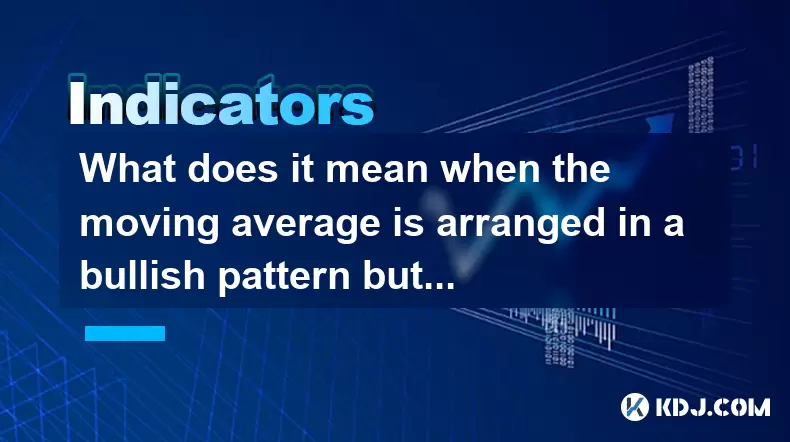
What does it mean when the moving average is arranged in a bullish pattern but the MACD bar is shortened?
Jul 27,2025 at 06:07am
Understanding the Bullish Moving Average PatternWhen traders observe a bullish moving average pattern, they typically refer to a configuration where s...

What signal does the ROC send when it rises rapidly from a low level and breaks through the zero axis?
Jul 27,2025 at 10:15am
Understanding the Rate of Change (ROC) IndicatorThe Rate of Change (ROC) is a momentum-based oscillator used in technical analysis to measure the perc...

What does it mean that the rebound is blocked after the moving average is arranged in a short position for the first time?
Jul 26,2025 at 10:51am
Understanding the Short-Term Moving Average ConfigurationWhen traders refer to a 'short position arrangement' in moving averages, they are describing ...

What does it mean that the parabolic indicator and the price break through the previous high at the same time?
Jul 26,2025 at 07:22pm
Understanding the Parabolic Indicator (SAR)The Parabolic SAR (Stop and Reverse) is a technical analysis tool developed by J. Welles Wilder to identify...

What does it mean that the upper and lower tracks of the Bollinger Band open upward at the same time?
Jul 27,2025 at 02:49pm
Understanding the Bollinger Band StructureThe Bollinger Band is a widely used technical analysis tool developed by John Bollinger. It consists of thre...

What does it mean that the price falls below the short-term moving average after the RSI top divergence?
Jul 26,2025 at 11:01pm
Understanding RSI Top Divergence in Cryptocurrency TradingThe Relative Strength Index (RSI) is a momentum oscillator widely used in cryptocurrency tra...

What does it mean when the moving average is arranged in a bullish pattern but the MACD bar is shortened?
Jul 27,2025 at 06:07am
Understanding the Bullish Moving Average PatternWhen traders observe a bullish moving average pattern, they typically refer to a configuration where s...
See all articles

























































































